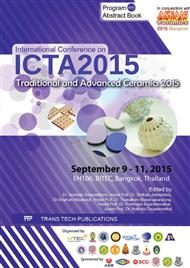p.143
p.150
p.156
p.162
p.167
p.173
p.179
p.187
p.194
Evaluation of Electrostatic Charge of Inorganic Pigments Coated by Silanes for Laser Beam Printer
Abstract:
LBP has six steps, which are charging, exposure, development, transfer, fusing, cleaning and discharge, for the printing product. In these steps, we focused on the development step for the source of submicron inorganic pigments. The toner is a negatively charged combination of inorganic particles. A control blade holds the toner at a micro size distance from the drum. The inorganic pigment then moves from the control blade to the more positively charged latent image on the drum. The image in static electricity needs to be developed – made visible. The developer introduces small particles of toner onto the static-charged surface of the drum. In this study inorganic pigments were coated by functional silanes to provide particles with the electrostatic charge. The coating thickness and kinds of silanes were changed to evaluate the electrostatic charge of coated pigments. After coating process, the electrostatic charge of inorganic pigments coated with silanes were evaluated by the Faraday’s device. We will introduce the effect of 3-(N-phenylamino) propyltrimethoxy silane and phenyl tris (methylethylketoxime) silane coating on the electrostatic charge of inorganic pigments.
Info:
Periodical:
Pages:
167-172
Citation:
Online since:
May 2016
Authors:
Price:
Сopyright:
© 2016 Trans Tech Publications Ltd. All Rights Reserved
Share:
Citation:


